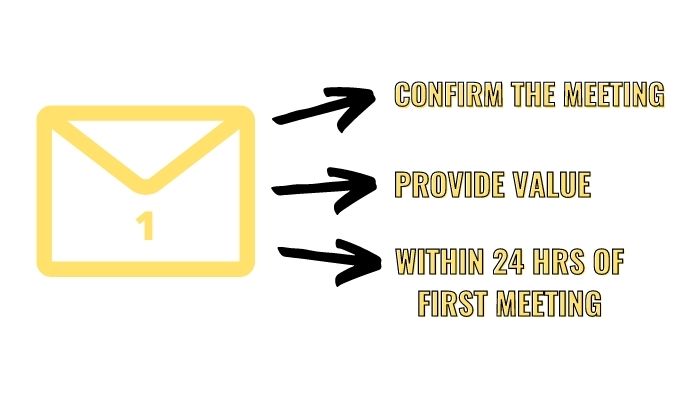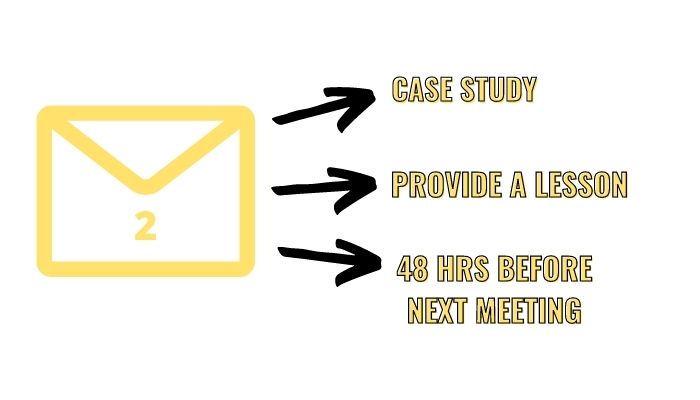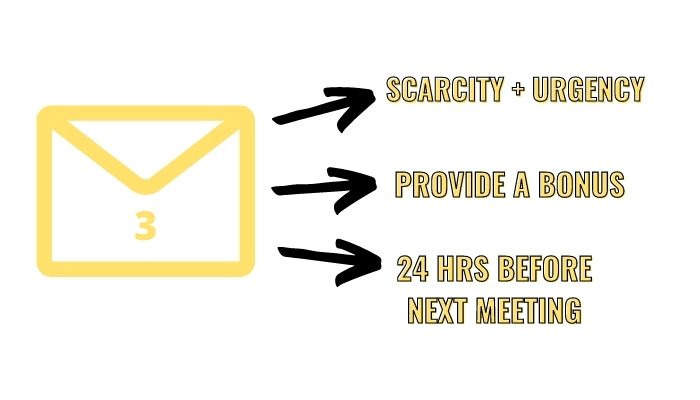If you work in the B2B space, you might be able to relate to this situation:
You have a sales call with a prospect trying to sell a complex or big-ticket product, and it’s an awesome call. The meeting has purpose, conversation flows, everything goes in the right direction, and then they say that they’ll get on the phone with you again to make a decision- great!
Then you try and book them in for a decision call, and you hear nothing. Crackle, crickets, radio silence. They waste time and drag their feet, and then when you finally get them to show up to a decision call, you can’t get them to part ways with their cash in exchange for your product or service. Sad violin music moment.
That’s what we’re going to be talking about today in this article, as well as how to overcome it using the Call to Close Method™. This method contains a simple three-step process consisting of three emails.
The First Email: Elevating Anticipation
To kick off the Call to Close Method™, we start with the confirmation of the meeting. In this email, we confirm the meeting, but also ensure we provide value.
So what are you doing for someone? What are you doing after you book that decision call? If it happens to go to that procedure call?
You should be sending an email like this:
Subject line: ‘Great to connect today, here’s a sweet bonus for your time’.
“Hey, John, thanks for connecting with me today, I look forward to a decision call on the 27th of March. You know what you have to do, If you have any questions, just holler at me, and I’m here to help.
In the meantime, it occurred to me that your ecosystem might be the one critical thing that’s holding you back from turning your business into that, you know, $3 million powerhouse that you’re looking for over the next six months, and that’s why I’m sharing this resource with you. It’s something I usually save for my paying clients, but it’s yours to keep, because I think it’s really going to help you find ways to get to $3 million faster.
(Insert the URL)
I look forward to chatting on the date.”
You can see the value in this type of email. We connect, we confirm the appointment that’s coming up, but we’re also continually sharing value. It’s also important to provide value that is specific and relevant to your prospect, for example, $3 million in the example shown above. The way we do this is by spending some time in the initial meeting figuring out what is holding the prospect back. To work out what the biggest thing is that’s holding the prospect back, we ask them about their obstacles.
When choosing what you want to attach to your email, you need to make sure that the attachment also provides value to your prospect. In our world, we like to attach a video that gives an answer to our prospects’ problems. With this type of video, you can see that it shows the prospect that we know what we are talking about, which will, in turn, make them think: “Great! These guys are the real deal!”
Sending an email like this to confirm the meeting, while providing value at the same time, is an incredible way to elevate anticipation. This is the first email in our sequence that we want to send out, preferably within 24 hours of your initial meeting so that the idea is fresh in your prospects’ mind.

The Second Email: Raise your glass!
In this second email, we want to provide a case study. This acts as a form of social proof; showing your prospects that your current clients love your product or service!
The case study that we send in this second email should also be a lesson. For example, you might have a video of someone talking about how you helped them systemize their ecosystem, and now they’re turning over an extra 25% in revenue per year. You want to detail why you know that, and that’s why you’ve got this result.
Your second email could go something like this:
Subject line: Did you know that champagne can reduce bad cholesterol?
“True Story by the way, but that’s not what this email is about.
I reckon all wins, however big or small, should require a mandatory champagne toast, don’t you agree?
That’s why before we chat on the 25th, I want to share this really awesome video.
(Insert URL of your testimonial or case study)
I’ll leave this testimonial in your hands. If you think it’s worth a glass of champagne, let me know and I will have one for you out on the 25th.”
As you can see, this second email is incredibly simple, it’s just a case study. Just don’t forget to make it a lesson as well. There’s no value in a testimonial that is one of those “I own a Ferrari, look at how good I am!” type of testimonials. Make it a testimonial that provides real value, and a lesson that someone can learn from when they see the results that have been achieved by someone else.
This email should be sent 48 hours before the next meeting, so you can place a ‘win’ at the top of your clients’ mind when they meet with you next.

The Third Email: Scarcity, Urgency, and Bonuses!
The third and final email is ‘crunch time.’ In this email, we need to make an offer that involves scarcity and urgency. We want to make sure that the decision call really does lead to a decision.
With many calls now taking place over Zoom, we need to make sure we really close the book when it comes to decision calls with prospects. Don’t give them too much time that they create objections or excuses.
In this email, we like to reward the proactive, which means that if the prospect is willing to make a decision, we sweeten the deal for them. Sweetening the deal does not mean discounting, let’s be clear on that. The way we sweeten the deal is by giving bonuses and adding value with an offer.
So, without further ado, here’s how we write our third email:
Subject line: I’ll see you on the call.
“Hey, John,
It’s customary for me to send a video walkthrough of our program around 24 hours before any decision call. Here’s a copy of that video with a password.
I’ve also attached a copy of the document I share in the video. If you have any questions come and find me otherwise, I look forward to tomorrow.”
You might read this email and wonder, where is the offer? Well, we like to include the offer in the video, rather than the written email. We want them to listen to the words we are saying, not just eyeball-skip across the page and see dollar signs that they won’t absorb. We prefer to shoot a selfie video speaking to the prospect and providing them with an offer.
The offer itself is a big consideration, and it’s also where scarcity and urgency come into play. The idea behind urgency is that ‘there’s a date, and it’s got to happen by this date, or this time in our call, as this will be my last opportunity to deliver this type of offer to you’. Ensure your bonus has a deadline of 24-8 hours before the meeting so that your prospect has time to digest it, especially if it’s over $10,000.
If you’re wondering about how to create scarcity, take this real-life scenario as an example:
What happened when toilet paper rolls flew off the shelves during the beginning of the COVID-19 pandemic? People went to buy more toilet paper rolls. The supermarkets were smart, they said “Don’t worry, we’ve got plenty of stock.”, but you couldn’t see that stock. This was enough to make people buy toilet paper like crazy because they didn’t know when they were going to get it next.
The idea behind scarcity is that you need to put some sort of limit on the offer. In our world, this is along the lines of “Listen, my diary is currently jam-packed for the next few weeks. But if we can make a decision, I can get you started tomorrow.”
When we’re creating scarcity, we also still keep in mind the idea of ‘rewarding the proactive.’ In our world, this comes in the form of giving a money-back guarantee to those who are willing to take action, because we’re willing to put proof in the pudding, but not for those who want to waste our time. A money-back guarantee is another good example of something that you can use in the framework of scarcity.
To top off our offer, we like to provide a bonus. We always like to work in threes, and in this situation, that’s scarcity, urgency, and a bonus. The best bonuses are those that don’t cost us a lot of money, or cost us a lot of time, but they solve a quick headache that the prospect has.
And that’s the third email complete. We like to send this email 24 hours before a meeting so that it’s fresh in the prospects’ mind.

